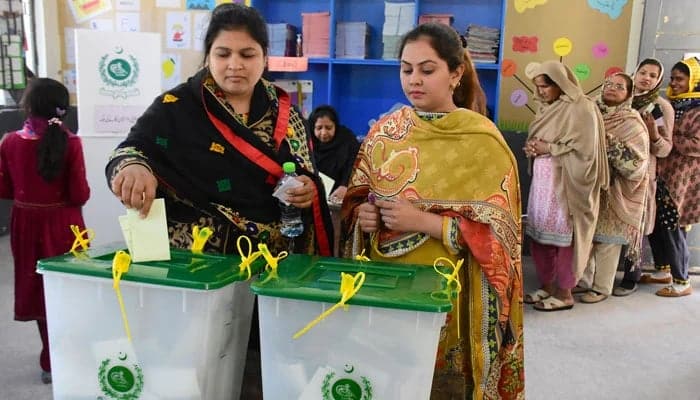February 8 polls saw 47.6% turnout, as compared to 52.1% in 2018.
Registered voters increased from 106mn in 2018 to 128.6mn in 2024.
22.6mn voters registered between 2018 and 2024.
ISLAMABAD: On February 8, around 60.6 million voters in Pakistan exercised their voting rights for the country’s 12th general elections, marking a climb in comparison to the 2018 elections when at least 54.8 million citizens participated, reflecting an increase of at least 5.8 million voters, the Free and Fair Election Network (Fafen) said in its post-election analysis report.
However, according to the election watchdog, the voter turnout in the recently held general polls saw a decline as opposed to the number of total voters registered. In comparison to the 52.1% voter turnout in 2018, the February 8 polls saw a 47.6% turnout.
The decrease in turnout, however, can be largely attributed to the increase in registered voters from 106 million in 2018 to 128.6 million in 2024. A considerable rise of 22.6 million registered voters between the 2018 and 2024 elections was highlighted by Fafen in its report.
Additionally, the harsh winter in parts of the country, fears of violence and terrorism in Khyber Pakhtunkhwa and Balochistan as well as uncertainty about the conduct of elections may have also adversely affected the turnout, the report stated.
The report is based on the analysis of Form 47 (provisional consolidated statement of results of the count) of 264 National Assembly constituencies acquired from the official website of the Election Commission of Pakistan (ECP).
The gender analysis of voter turnout, however, needs further refinement as Form 47 from 10 National Assembly constituencies and as many provincial assemblies, constituencies did not include the gender disaggregation of votes polled.
According to the voter turnout analysis report of the Fafen, Khyber Pakhtunkhwa records the lowest turnout and stated that the regional disaggregation of voter turnout for National Assembly constituencies shows a varied pattern with the lowest turnout in Khyber Pakhtunkhwa and the highest in Islamabad Capital Territory (ICT).
The turnout in Khyber Pakhtunkhwa declined from 44% in 2018 to 39.5% in 2024, in ICT from 58.3% to 54.2%, in Punjab from 56.8% to 51.6%, in Sindh from 47.2% to 43.7% and in Balochistan from 45.3% to 42.9%. While overall turnout declined by 4.5%, the highest decline was in Punjab where turnout dropped by 5.2%, followed by KP (4.5pc), ICT (4.1pc), Sindh (3.5pc) and Balochistan (2.4pc).
The gender-disaggregated statistics of polled votes indicate a male voter turnout of 51.6% and a female voter turnout of 42.6%.
According to the available data, as many as 24.05 million women cast their votes in 254 NA constituencies as compared to 34.02 million men in the same constituencies.
Interestingly, the increase in the number of women turning out to vote in 2024 as compared to 2018 is greater than the increase in the number of men who cast their votes in 2024 as compared to the previous general election.
Around 2.3 million more women turned out to vote in 2024 as compared to 2018 when 21.7 million women had cast their votes. On the other hand, as many as 1.09 million more men turned out to vote in 2024 as compared to 2018 when 32.9 million men cast their votes.
The number of votes polled by men and women will slightly increase when the ECP makes available the gender-disaggregated data of the 10 National Assembly constituencies where the returning officers did not separately record the votes polled by men and women.
The decline in turnout as compared to 2018 was a ubiquitous phenomenon across major cities including the provincial capitals — Lahore, Quetta, Peshawar and Karachi. Although the cumulative turnout of all 22 Karachi constituencies saw a declining trend, three Karachi districts namely Korangi, Karachi West and Karachi Central registered a slight increase in the turnout while Malir, Karachi South and Karachi East recorded a decline.
Among 264 constituencies, the highest turnout was 70.9% recorded in NA-214 Tharparkar-I while the lowest was 16.3% in NA-42 South Waziristan Upper-cum-South Waziristan Lower.
Nearly 97% of constituencies of Punjab, 70% of Sindh, 56% of Balochistan and 41% of KP have an above 40% turnout. Overall, 13 constituencies had a turnout above 60%, including nine constituencies in Punjab, two in Sindh and one in Khyber Pakhtunkhwa and ICT each.
As many as 103 constituencies had a turnout between 50.1% and 60%, including 87 in Punjab, 08 in Sindh, 04 in Balochistan, 03 in Khyber Pakhtunkhwa and 01 in ICT. Around 93 constituencies had a turnout between 40.1% and 50% with 40 such constituencies in Punjab, 33 in Sindh, 14 in Khyber Pakhtunkhwa, five in Balochistan and one in ICT.
Some 45 constituencies had a turnout between 30.1% and 40%, including 21 in Khyber Pakhtunkhwa, 16 in Sindh, and 4 in Balochistan and Punjab each.
The remaining 10 constituencies had a turnout below 30% and included five in Khyber Pakhtunkhwa, three in Balochistan and two in Sindh.
Unlike in 2018, none of the National or provincial assemblies’ constituencies recorded a female turnout that was less than 10% of the total polled votes. Section 9(1) empowers the commission to declare polling at one or more polling stations or election in the whole constituency void if the turnout of women voters in the constituency is less than 10% of the total votes polled.
The highest women’s vote share was 49.5% in NA-1 Chitral Upper-cum-Chitral Lower. Of 254 National Assembly constituencies where gender disaggregation of polled votes is available, six constituencies in Khyber Pakhtunkhwa had women votes that were less than 25% of the total votes. Women’s share in polled votes was between 25.1% and 35% in 24 constituencies, between 35.1% and 45% in 197 constituencies and above 45% in 27 constituencies.

